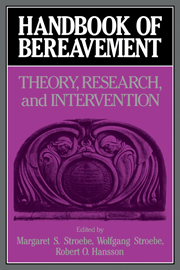Book contents
- Frontmatter
- Contents
- Contributors
- Preface
- Part I Introduction
- Part II The phenomenology and measurement of grief
- Part III Current theories of grief, mourning, and bereavement
- 5 Grief as an emotion and as a disease: A social-constructionist perspective
- 6 Bereavement as a psychosocial transition: Processes of adaptation to change
- 7 Grief: The social context of private feelings
- 8 Bereavement from the perspective of cognitive-experiential self-theory
- Part IV Physiological changes following bereavement
- Part V The psychological, social, and health impacts of conjugal bereavement
- Part VI Grief reactions to different types of loss
- Part VII Coping, counseling, and therapy
- Part VIII Conclusions
- References
- Author index
- Subject Index
7 - Grief: The social context of private feelings
Published online by Cambridge University Press: 04 May 2010
- Frontmatter
- Contents
- Contributors
- Preface
- Part I Introduction
- Part II The phenomenology and measurement of grief
- Part III Current theories of grief, mourning, and bereavement
- 5 Grief as an emotion and as a disease: A social-constructionist perspective
- 6 Bereavement as a psychosocial transition: Processes of adaptation to change
- 7 Grief: The social context of private feelings
- 8 Bereavement from the perspective of cognitive-experiential self-theory
- Part IV Physiological changes following bereavement
- Part V The psychological, social, and health impacts of conjugal bereavement
- Part VI Grief reactions to different types of loss
- Part VII Coping, counseling, and therapy
- Part VIII Conclusions
- References
- Author index
- Subject Index
Summary
Grief is shaped by the social context in which it occurs (Averill, 1968). Two theories that provide a useful perspective in this connection are symbolic interaction theory (e.g., Berger & Kellner, 1964; Cochran & Claspell, 1987; Lofland, 1985; Marris, 1974; Rosenblatt & Wright, 1984) and family systems theory (e.g., Berkowitz, 1977; Krell & Rabkin, 1979; Rosenblatt, 1983, chapter 10). These two theories complement each other, illuminate the complexity and challenges bereaved people face in coming to terms with a loss, and demonstrate why the social context of grief is so important. Symbolic interaction theory emphasizes the social nature of reality and suggests how a significant loss might be viewed as a loss of reality. It also helps us understand how others are important in defining, feeling, and coming to terms with a loss. Family systems theory emphasizes how family rules and patterns shape loss experiences and how a significant loss affects and is played out in a system of family relationships.
In this chapter symbolic interaction theory and family systems theory are briefly outlined as they apply to bereavement. Then both theories are used to develop a perspective on social relationships in grieving and support, on social prescriptions for the bereaved, and on the limits of social knowledge of grief.
Defining a loss
The loss of definitional context
From the viewpoint of symbolic interaction theory, part of the social context for understanding, organizing, validating, and defining feeling, action, values, and priorities is removed when a significant person is lost.
- Type
- Chapter
- Information
- Handbook of BereavementTheory, Research, and Intervention, pp. 102 - 111Publisher: Cambridge University PressPrint publication year: 1993
- 32
- Cited by



